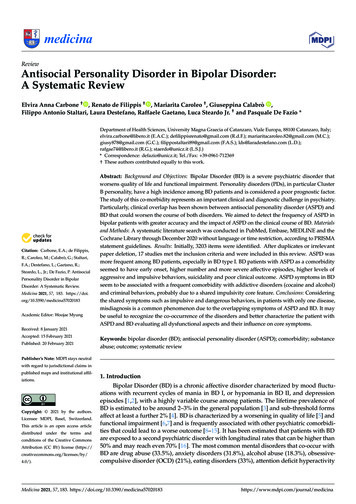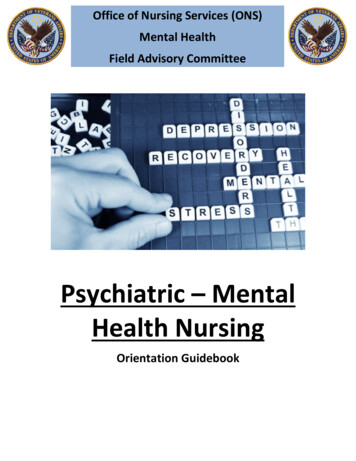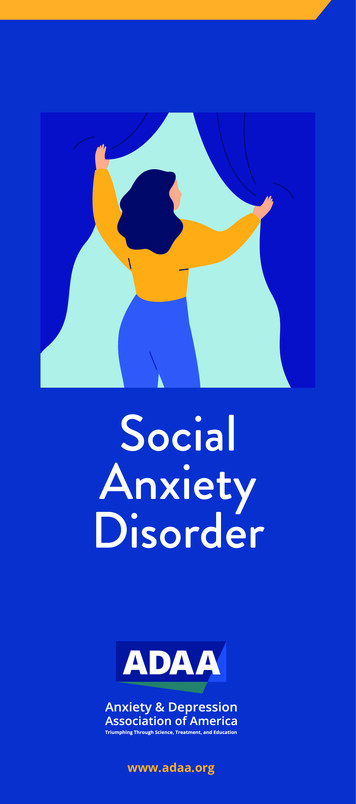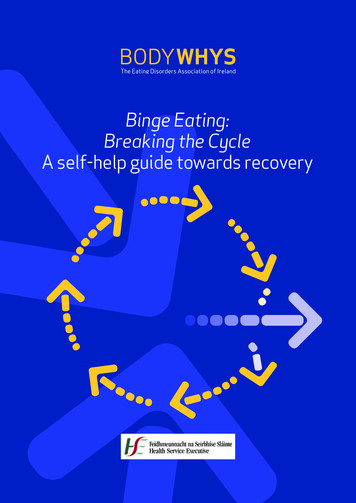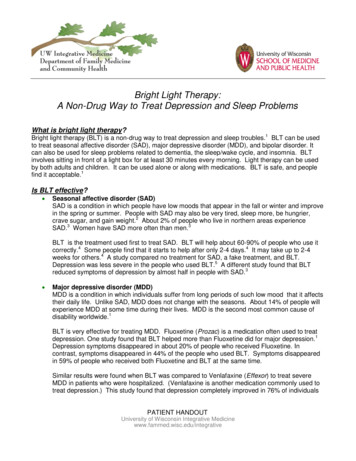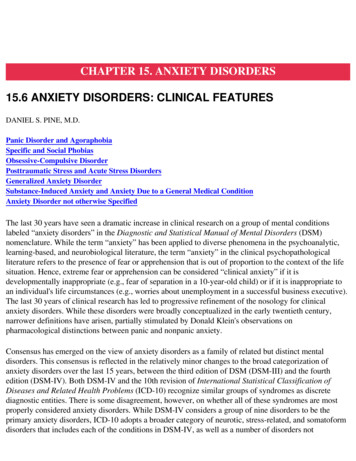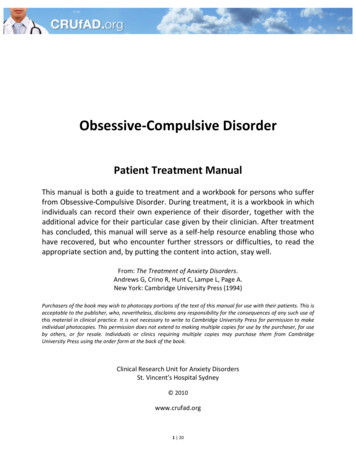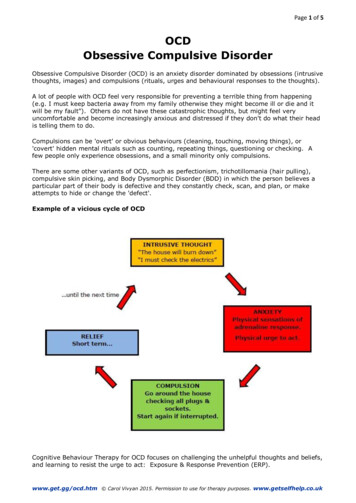
Transcription
Bipolar DisorderNational Institute of Mental HealthU.S. DEPARTMENT OF HEALTH AND HUMAN SERVICES National Institutes of Health
ContentsWhat is bipolar disorder? 1What are the symptoms of bipolar disorder? 1How does bipolar disorder affect someone over time? 4What illnesses often co-exist with bipolar disorder? 6What are the risk factors for bipolar disorder? 6Genetics 6Brain structure and functioning 8How is bipolar disorder diagnosed? 8How is bipolar disorder treated? 9Medications 9Psychotherapy 16Other treatments 17What can people with bipolar disorder expect from treatment? 19How can I help a friend or relative who has bipolar disorder? 19Support for caregivers 20How can I help myself if I have bipolar disorder? 20Where can I go for help? 21What if I or someone I know is in crisis? 21Citations 22For more information on bipolar disorder 26
This booklet discusses bipolar disorder inadults. For information on bipolar disorderin children and adolescents, see the NIMHbooklet, “Bipolar Disorder in Children andTeens: A Parent’s Guide.”
What is bipolar disorder?Bipolar disorder, also known as manic-depressiveillness, is a brain disorder that causes unusualshifts in mood, energy, activity levels, and theability to carry out day-to-day tasks. Symptomsof bipolar disorder are severe. They are differentfrom the normal ups and downs that everyonegoes through from time to time. Bipolar disordersymptoms can result in damaged relationships,poor job or school performance, and even suicide. But bipolar disorder can betreated, and people with this illness can lead full and productive lives.Bipolar disorder often develops in a person’s late teens or early adult years. Atleast half of all cases start before age 25.1 Some people have their first symptomsduring childhood, while others may develop symptoms late in life.Bipolar disorder is not easy to spot when it starts. The symptoms may seem likeseparate problems, not recognized as parts of a larger problem. Some people suffer for years before they are properly diagnosed and treated. Like diabetes or heartdisease, bipolar disorder is a long-term illness that must be carefully managedthroughout a person’s life.What are the symptoms of bipolar disorder?People with bipolar disorder experience unusually intense emotional states thatoccur in distinct periods called “mood episodes.” An overly joyful or overexcitedstate is called a manic episode, and an extremely sad or hopeless state is calleda depressive episode. Sometimes, a mood episode includes symptoms of bothmania and depression. This is called a mixed state. People with bipolar disorderalso may be explosive and irritable during a mood episode.Extreme changes in energy, activity, sleep, and behavior go along with thesechanges in mood. It is possible for someone with bipolar disorder to experience along-lasting period of unstable moods rather than discrete episodes of depressionor mania.A person may be having an episode of bipolar disorder if he or she has a numberof manic or depressive symptoms for most of the day, nearly every day, for at leastone or two weeks. Sometimes symptoms are so severe that the person cannotfunction normally at work, school, or home.Bipolar Disorder 1
Symptoms of bipolar disorder are described below.Symptoms of mania or a manicepisode include:Symptoms of depression or adepressive episode include:Mood ChangesMood Changes A long period of feeling “high,” oran overly happy or outgoing mood A long period of feeling worried orempty Extremely irritable mood, agitation, feeling “jumpy” or “wired.” Loss of interest in activities onceenjoyed, including sex.Behavioral ChangesBehavioral Changes Talking very fast, jumping fromone idea to another, having racingthoughts Feeling tired or “slowed down” Being easily distracted Increasing goal-directed activities,such as taking on new projects Being restless Sleeping little Having an unrealistic belief inone’s abilities Behaving impulsively and takingpart in a lot of pleasurable, highrisk behaviors, such as spendingsprees, impulsive sex, and impulsive business investments.2 National Institute of Mental Health Having problems concentrating, remembering, and makingdecisions Being restless or irritable Changing eating, sleeping, orother habits Thinking of death or suicide, orattempting suicide.
In addition to mania and depression, bipolar disorder can cause a range of moods,as shown on the scale.severe depression,moderate depression, andmild low moodnormal orbalanced moodhypomania andsevere maniaOne side of the scale includes severe depression, moderate depression, and mildlow mood. Moderate depression may cause less extreme symptoms, and mild lowmood is called dysthymia when it is chronic or long-term. In the middle of the scaleis normal or balanced mood.At the other end of the scale are hypomania and severe mania. Some people withbipolar disorder experience hypomania. During hypomanic episodes, a person mayhave increased energy and activity levels that are not as severe as typical mania,or he or she may have episodes that last less than a week and do not requireemergency care. A person having a hypomanic episode may feel very good, behighly productive, and function well. This person may not feel that anything iswrong even as family and friends recognize the mood swings as possible bipolardisorder. Without proper treatment, however, people with hypomania may developsevere mania or depression.Bipolar Disorder 3
During a mixed state, symptoms often include agitation, trouble sleeping, majorchanges in appetite, and suicidal thinking. People in a mixed state may feel verysad or hopeless while feeling extremely energized.Sometimes, a person with severe episodes of mania or depression has psychoticsymptoms too, such as hallucinations or delusions. The psychotic symptoms tendto reflect the person’s extreme mood. For example, psychotic symptoms for a person having a manic episode may include believing he or she is famous, has a lot ofmoney, or has special powers. In the same way, a person having a depressive episode may believe he or she is ruined and penniless, or has committed a crime. Asa result, people with bipolar disorder who have psychoticsymptoms are sometimes wrongly diagnosed as havingschizophrenia, another severe mental illness that is linkedwith hallucinations and delusions.People with bipolar disorder may also have behavioralproblems. They may abuse alcohol or substances, haverelationship problems, or perform poorly in school or atwork. At first, it’s not easy to recognize these problemsas signs of a major mental illness.How does bipolar disorder affect someoneover time?Bipolar disorder usually lasts a lifetime. Episodes of mania and depression typicallycome back over time. Between episodes, many people with bipolar disorder arefree of symptoms, but some people may have lingering symptoms.Doctors usually diagnose mental disorders using guidelines from the Diagnosticand Statistical Manual of Mental Disorders, or DSM. According to the DSM, thereare four basic types of bipolar disorder:1. Bipolar I Disorder is mainly defined by manic or mixed episodes that last atleast seven days, or by manic symptoms that are so severe that the personneeds immediate hospital care. Usually, the person also has depressive episodes, typically lasting at least two weeks. The symptoms of mania or depression must be a major change from the person’s normal behavior.4 National Institute of Mental Health
2. Bipolar II Disorder is defined by a pattern of depressive episodes shifting back and forth with hypomanicepisodes, but no full-blown manic or mixed episodes.3. Bipolar Disorder Not Otherwise Specified(BP-NOS) is diagnosed when a person has symptoms of the illness that do not meet diagnostic criteriafor either bipolar I or II. The symptoms may not lastlong enough, or the person may have too few symptoms, to be diagnosed with bipolar I or II. However,the symptoms are clearly out of the person’s normalrange of behavior.4. Cyclothymic Disorder, or Cyclothymia, is a mild form of bipolar disorder.People who have cyclothymia have episodes of hypomania that shift back andforth with mild depression for at least two years. However, the symptoms do notmeet the diagnostic requirements for any other type of bipolar disorder.Some people may be diagnosed with rapid-cycling bipolar disorder. This is whena person has four or more episodes of major depression, mania, hypomania, ormixed symptoms within a year.2 Some people experience more than one episodein a week, or even within one day. Rapid cycling seems to be more common inpeople who have severe bipolar disorder and may be more common in peoplewho have their first episode at a younger age. One study found that people withrapid cycling had their first episode about four years earlier, during mid to late teenyears, than people without rapid cycling bipolar disorder.3 Rapid cycling affectsmore women than men.4Bipolar disorder tends to worsen if it is not treated. Over time, a person may suffermore frequent and more severe episodes than when the illness first appeared.5Also, delays in getting the correct diagnosis and treatment make a person morelikely to experience personal, social, and work-related problems.6Proper diagnosis and treatment helps people with bipolar disorder lead healthyand productive lives. In most cases, treatment can help reduce the frequency andseverity of episodes.Bipolar Disorder 5
What illnesses often co-existwith bipolar disorder?Substance abuse is very common among peoplewith bipolar disorder, but the reasons for this link areunclear.7 Some people with bipolar disorder may try totreat their symptoms with alcohol or drugs. However,substance abuse may trigger or prolong bipolar symptoms, and the behavioral control problems associatedwith mania can result in a person drinking too much.Anxiety disorders, such as post-traumatic stress disorder (PTSD) and socialphobia, also co-occur often among people with bipolar disorder.8-10 Bipolar disorder also co-occurs with attention deficit hyperactivity disorder (ADHD), which hassome symptoms that overlap with bipolar disorder, such as restlessness and beingeasily distracted.People with bipolar disorder are also at higher risk for thyroid disease, migraineheadaches, heart disease, diabetes, obesity, and other physical illnesses.10, 11These illnesses may cause symptoms of mania or depression. They may also resultfrom treatment for bipolar disorder (see “Lithium and Thyroid Function” section onpage 10).Other illnesses can make it hard to diagnose and treat bipolar disorder. Peoplewith bipolar disorder should monitor their physical and mental health. If a symptomdoes not get better with treatment, they should tell their doctor.What are the risk factors for bipolar disorder?Scientists are learning about the possible causes of bipolar disorder. Most scientists agree that there is no single cause. Rather, many factors likely act together toproduce the illness or increase risk.GeneticsBipolar disorder tends to run in families, so researchers are looking for genes thatmay increase a person’s chance of developing the illness. Genes are the “building blocks” of heredity. They help control how the body and brain work and grow.Genes are contained inside a person’s cells that are passed down from parents tochildren.6 National Institute of Mental Health
Children with a parent or sibling who has bipolar disorder are four to six timesmore likely to develop the illness, compared with children who do not have a familyhistory of bipolar disorder.12 However, most children with a family history of bipolardisorder will not develop the illness.Genetic research on bipolar disorder is being helped byadvances in technology. This type of research is nowmuch quicker and more far-reaching than in the past. Oneexample is the launch of the Bipolar Disorder PhenomeDatabase, funded in part by NIMH. Using the database,scientists will be able to link visible signs of the disorderwith the genes that may influence them. So far, researchersusing this database found that most people with bipolardisorder had:13 Missed work because of their illness Other illnesses at the same time, especially alcohol and/or substance abuseand panic disorders Been treated or hospitalized for bipolar disorder.The researchers also identified certain traits that appeared to run in families,including: History of psychiatric hospitalization Co-occurring obsessive-compulsive disorder (OCD) Age at first manic episode Number and frequency of manic episodes.Scientists continue to study these traits, which may help them find the genes thatcause bipolar disorder some day.But genes are not the only risk factor for bipolar disorder. Studies of identical twinshave shown that the twin of a person with bipolar illness does not always developthe disorder. This is important because identical twins share all of the same genes.The study results suggest factors besides genes are also at work. Rather, it islikely that many different genes and a person’s environment are involved. However,scientists do not yet fully understand how these factors interact to cause bipolardisorder.Bipolar Disorder 7
Brain structure and functioningBrain-imaging studies are helping scientists learn whathappens in the brain of a person with bipolar disorder.14, 15Newer brain-imaging tools, such as functional magneticresonance imaging (fMRI) and positron emission tomography (PET), allow researchers to take pictures of the livingbrain at work. These tools help scientists study the brain’sstructure and activity.Some imaging studies show how the brains of people with bipolar disorder maydiffer from the brains of healthy people or people with other mental disorders.For example, one study using MRI found that the pattern of brain development inchildren with bipolar disorder was similar to that in children with “multi-dimensionalimpairment,” a disorder that causes symptoms that overlap somewhat with bipolardisorder and schizophrenia.16 This suggests that the common pattern of braindevelopment may be linked to general risk for unstable moods.Learning more about these differences, along with information gained from geneticstudies, helps scientists better understand bipolar disorder. Someday scientistsmay be able to predict which types of treatment will work most effectively. Theymay even find ways to prevent bipolar disorder.How is bipolar disorder diagnosed?The first step in getting a proper diagnosis is totalk to a doctor, who may conduct a physicalexamination, an interview, and lab tests. Bipolardisorder cannot currently be identified througha blood test or a brain scan, but these tests canhelp rule out other contributing factors, such asa stroke or brain tumor. If the problems are notcaused by other illnesses, the doctor may conduct a mental health evaluation. Thedoctor may also provide a referral to a trained mental health professional, such asa psychiatrist, who is experienced in diagnosing and treating bipolar disorder.The doctor or mental health professional should conduct a complete diagnosticevaluation. He or she should discuss any family history of bipolar disorder or othermental illnesses and get a complete history of symptoms. The doctor or mentalhealth professionals should also talk to the person’s close relatives or spouse andnote how they describe the person’s symptoms and family medical history.8 National Institute of Mental Health
People with bipolar disorder are more likely to seek help when they are depressedthan when experiencing mania or hypomania.17 Therefore, a careful medical historyis needed to assure that bipolar disorder is not mistakenly diagnosed as majordepressive disorder, which is also called unipolar depression. Unlike people withbipolar disorder, people who have unipolar depression do not experience mania.Whenever possible, previous records and input from family and friends should alsobe included in the medical history.How is bipolar disorder treated?To date, there is no cure for bipolar disorder. But proper treatment helps mostpeople with bipolar disorder gain better control of their mood swings and relatedsymptoms.18-20 This is also true for people with the most severe forms of the illness.Because bipolar disorder is a lifelong and recurrent illness, people with the disorder need long-term treatment to maintain control of bipolar symptoms. An effectivemaintenance treatment plan includes medication and psychotherapy for preventingrelapse and reducing symptom severity.21MedicationsBipolar disorder can be diagnosed and medications prescribed by people with an M.D. (doctor of medicine).Usually, bipolar medications are prescribed by a psychiatrist. In some states, clinical psychologists, psychiatricnurse practitioners, and advanced psychiatric nurse specialists can also prescribe medications. Check with your state’slicensing agency to find out more.Not everyone responds to medications in the same way. Several different medications may need to be tried before the best course of treatment is found.Keeping a chart of daily mood symptoms, treatments, sleep patterns, and lifeevents can help the doctor track and treat the illness most effectively. Sometimesthis is called a daily life chart. If a person’s symptoms change or if side effectsbecome serious, the doctor may switch or add medications.Some of the types of medications generally used to treat bipolar disorder are listedon the next page. Information on medications can change. For the most up to dateinformation on use and side effects contact the U.S. Food and Drug Administration(FDA) at http://www.fda.gov.Bipolar Disorder 9
1. Mood stabilizing medications are usually the first choice to treat bipolardisorder. In general, people with bipolar disorder continue treatment with moodstabilizers for years. Except for lithium, many of these medications are anticonvulsants. Anticonvulsant medications are usually used to treat seizures, butthey also help control moods. These medications are commonly used as moodstabilizers in bipolar disorder: Lithium (sometimes known as Eskalith or Lithobid) was the first mood-stabilizingmedication approved by the U.S. Food and Drug Administration (FDA) in the1970s for treatment of mania. It is often very effective in controlling symptomsof mania and preventing the recurrence of manic and depressive episodes. Valproic acid or divalproex sodium (Depakote), approved by the FDA in 1995for treating mania, is a popular alternative to lithium for bipolar disorder. It isgenerally as effective as lithium for treating bipolar disorder.23, 24 Also see thesection in this booklet, “Should young women take valproic acid?” More recently, the anticonvulsant lamotrigine (Lamictal) received FDAapproval for maintenance treatment of bipolar disorder. Other anticonvulsant medications, including gabapentin (Neurontin), topiramate (Topamax), and oxcarbazepine (Trileptal) are sometimes prescribed.No large studies have shown that these medications are more effective thanmood stabilizers.Valproic acid, lamotrigine, and other anticonvulsant medications have an FDAwarning. The warning states that their use may increase the risk of suicidalthoughts and behaviors. People taking anticonvulsant medications for bipolar orother illnesses should be closely monitored for new or worsening symptoms ofdepression, suicidal thoughts or behavior, or any unusual changes in mood orbehavior. People taking these medications should not make any changes without talking to their health care professional.Lithium and Thyroid FunctionPeople with bipolar disorder often have thyroid gland problems. Lithium treatment may alsocause low thyroid levels in some people.22 Low thyroid function, called hypothyroidism, has beenassociated with rapid cycling in some people with bipolar disorder, especially women.Because too much or too little thyroid hormone can lead to mood and energy changes, it isimportant to have a doctor check thyroid levels carefully. A person with bipolar disorder mayneed to take thyroid medication, in addition to medications for bipolar disorder, to keep thyroidlevels balanced.10 National Institute of Mental Health
Should young women take valproic acid?Valproic acid may increase levels of testosterone (a male hormone) in teenage girls and lead topolycystic ovary syndrome (PCOS) in women who begin taking the medication before age 20.25, 26PCOS causes a woman’s eggs to develop into cysts, or fluid filled sacs that collect in the ovariesinstead of being released by monthly periods. This condition can cause obesity, excess body hair,disruptions in the menstrual cycle, and other serious symptoms. Most of these symptoms willimprove after stopping treatment with valproic acid.27 Young girls and women taking valproic acidshould be monitored carefully by a doctor.2. Atypical antipsychotic medications are sometimes used to treat symptomsof bipolar disorder. Often, these medications are taken with other medications. Atypical antipsychotic medications are called “atypical” to set them apartfrom earlier medications, which are called “conventional” or “first-generation”antipsychotics. Olanzapine (Zyprexa), when given with an antidepressant medication, mayhelp relieve symptoms of severe mania or psychosis.28 Olanzapine is alsoavailable in an injectable form, which quickly treats agitation associatedwith a manic or mixed episode. Olanzapine can be used for maintenancetreatment of bipolar disorder as well, even when a person does not havepsychotic symptoms. However, some studies show that people takingolanzapine may gain weight and have other side effects that can increasetheir risk for diabetes and heart disease. These side effects are more likelyin people taking olanzapine when compared with people prescribed otheratypical antipsychotics. Aripiprazole (Abilify), like olanzapine, is approved for treatment of a manicor mixed episode. Aripiprazole is also used for maintenance treatment aftera severe or sudden episode. As with olanzapine, aripiprazole also can beinjected for urgent treatment of symptoms of manic or mixed episodes ofbipolar disorder. Quetiapine (Seroquel) relieves the symptoms of severe and sudden manicepisodes. In that way, quetiapine is like almost all antipsychotics. In 2006, itbecame the first atypical antipsychotic to also receive FDA approval for thetreatment of bipolar depressive episodes. Risperidone (Risperdal) and ziprasidone (Geodon) are other atypical antipsychotics that may also be prescribed for controlling manic or mixed episodes.Bipolar Disorder 11
3. Antidepressant medications are sometimes used to treat symptoms ofdepression in bipolar disorder. People with bipolar disorder who take antidepressants often take a mood stabilizer too. Doctors usually require this becausetaking only an antidepressant can increase a person’s risk of switching tomania or hypomania, or of developing rapid cycling symptoms.29 To prevent thisswitch, doctors who prescribe antidepressants for treating bipolar disorder alsousually require the person to take a mood-stabilizing medication at the sametime.Recently, a large-scale, NIMH-funded study showed that for many people, adding an antidepressant to a mood stabilizer is no more effective in treating thedepression than using only a mood stabilizer.30 Fluoxetine (Prozac), paroxetine (Paxil), sertraline (Zoloft), and bupropion(Wellbutrin) are examples of antidepressants that may be prescribed to treatsymptoms of bipolar depression.Some medications are better at treating one type of bipolar symptoms thananother. For example, lamotrigine (Lamictal) seems to be helpful in controllingdepressive symptoms of bipolar disorder.What are the side effects of these medications?Before starting a new medication, people with bipolardisorder should talk to their doctor about the possiblerisks and benefits.The psychiatrist prescribing the medication or pharmacist can also answer questions about side effects.Over the last decade, treatments have improved, andsome medications now have fewer or more tolerableside effects than earlier treatments. However, everyoneresponds differently to medications. In some cases,side effects may not appear until a person has taken amedication for some time.If the person with bipolar disorder develops any severe side effects from a medication, he or she should talk to the doctor who prescribed it as soon as possible.The doctor may change the dose or prescribe a different medication. People beingtreated for bipolar disorder should not stop taking a medication without talking toa doctor first. Suddenly stopping a medication may lead to “rebound,” or worsening of bipolar disorder symptoms. Other uncomfortable or potentially dangerouswithdrawal effects are also possible.12 National Institute of Mental Health
FDA Warning on AntidepressantsAntidepressants are safe and popular, but some studies have suggested that they may have unintentional effects on some people, especially in adolescents and young adults. The FDA warningsays that patients of all ages taking antidepressants should be watched closely, especially duringthe first few weeks of treatment. Possible side effects to look for are depression that gets worse,suicidal thinking or behavior, or any unusual changes in behavior such as trouble sleeping,agitation, or withdrawal from normal social situations. Families and caregivers should report anychanges to the doctor. The latest information from the FDA can be found at http://www.fda.gov.The following sections describe some common side effects of the different typesof medications used to treat bipolar disorder.1. Mood StabilizersIn some cases, lithium can cause side effects such as: Restlessness Dry mouth Bloating or indigestion Acne Unusual discomfort to cold temperatures Joint or muscle pain Brittle nails or hair.31Lithium also causes side effects not listed here. If extremely bothersome orunusual side effects occur, tell your doctor as soon as possible.If a person with bipolar disorder is being treated with lithium, it is important tomake regular visits to the treating doctor. The doctor needs to check the levels oflithium in the person’s blood, as well as kidney and thyroid function.Bipolar Disorder 13
Common side effects of other mood stabilizingmedications include: Drowsiness Dizziness Headache Diarrhea Constipation HeartburnThese medications mayalso be linked with rarebut serious side effects.Talk with the treatingdoctor or a pharmacist tomake sure you understand signs of seriousside effects for the medications you’re taking. Mood swings Stuffed or runny nose, or other cold-like symptoms.32-372. Atypical AntipsychoticsSome people have side effects when they start taking atypical antipsychotics.Most side effects go away after a few days and often can be managed successfully. People who are taking antipsychotics should not drive until they adjust totheir new medication. Side effects of many antipsychotics include: Drowsiness Dizziness when changing positions Blurred vision Rapid heartbeat Sensitivity to the sun Skin rashes Menstrual problems for women.Atypical antipsychotic medications can cause major weight gain and changes ina person’s metabolism. This may increase a person’s risk of getting diabetes andhigh cholesterol.38 A person’s weight, glucose levels, and lipid levels should bemonitored regularly by a doctor while taking these medications.In rare cases, long-term use of atypical antipsychotic drugs may lead to a condition called tardive dyskinesia (TD). The condition causes muscle movementsthat commonly occur around the mouth. A person with TD cannot control thesemoments. TD can range from mild to severe, and it cannot always be cured. Somepeople with TD recover partially or fully after they stop taking the drug.14 National Institute of Mental Health
3. AntidepressantsThe antidepressants most commonly prescribed for treating symptoms of bipolardisorder can also cause mild side effects that usually do not last long. These caninclude: Headache, which usually goes away within a few days. Nausea (feeling sick to your stomach), which usually goes away within a few days. Sleep problems, such as sleeplessness or drowsiness. This may happen duringthe first few weeks but then go away. To help lessen these effects, sometimesthe medication dose can be reduced, or the time of day it is taken can bechanged. Agitation (feeling jittery). Sexual problems, which can affect both men and women. These includereduced sex drive and problems having and enjoying sex.Some antidepressants are more likely to cause certain side effects than othertypes. Your doctor or pharmacist can answer questions about these medications.Any unusual reactions or side effects should be reported to a doctor immediately.For the most up-to-date information on medications for treating bipolar disorder and their side effects, please see theonline NIMH Medications booklet at tions/complete-publication.shtml.Should women who are pregnant or may becomepregnant take medication for bipolar disorder?Women with
Anxiety disorders, such as post-traumatic stress disorder (PTSD) and social phobia, also co-occur often among people with bipolar disorder.8-10 Bipolar disor-der also co-occurs with attention deficit hyperactivity disorder (ADHD), which has some symptoms that overlap with bipolar disorder
